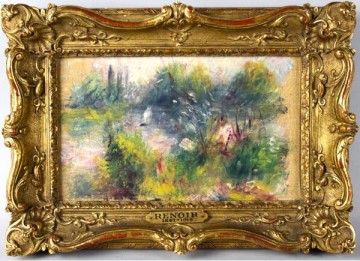
Originally published in the Marina Times San Francisco in November 2012
Treasures are found in the strangest and most unexpected of places, sometimes in our own backyard. That’s what a woman in Virginia discovered recently when she found a box in her shed. She’d purchased the collection of kitsch for $7 at a local flea market two years earlier, mostly for the Paul Bunyan doll and plastic cow.
A small painting caught her interest only because she’d wished to reuse the frame. After taking some good advice from someone who recommended that she have it appraised before altering the artwork, she discovered that she was in the possession of an original painting by none other than Pierre-Auguste Renoir. A leading figure of the Impressionist movement, Renoir painted “Paysage Bords de Seine,” or “Landscape on the Banks of the Seine” in 1879. The Potomack Co. auction house estimated that, at auction, the small work could fetch up to $100,000. The auction was scheduled for September 29.
Here the story takes a sharp turn worthy of a Raymond Chandler novel. A reporter from the Washington Post discovered documents suggesting that this same Renoir painting had been stolen out of the Baltimore Museum of Art in 1951. The Potomack Co. took the item off of the auction block and called the FBI who opened a formal investigation.
Previously the auction house had traced the painting’s provenance, a historical record of ownership, to an international lawyer who was the last recorded individual to have purchased the painting in Paris during 1926. And yet, mysteriously, the Baltimore Museum of Art had listed the last owner as art collector and local benefactor Sadie May. In a twist of fate, May died in the spring of 1951, and Renoir’s “Landscape on the Banks of the Seine”, on loan to the museum since 1937, was one of the works left to the museum in her will. At the time of the theft on November 17, 1951, the painting hadn’t been officially entered into the museum’s permanent collection. The painting was left off of the worldwide registry of stolen art since it had yet to be properly registered by the museum.
Was the painting stolen by a museum employee who understood that, under the circumstances, the theft might go unnoticed? How did it end up in a flea market in West Virginia? The case is currently under investigation. The Baltimore Museum of Art wants the piece to be returned, and The Potomack Co. wants more evidence of ownership by Sadie May before it will relinquish its right to auction the piece. A court case is likely.
Generally, there are two kinds of art thieves: First, there’s the thief motivated by pure greed. Most stolen art is recovered during an attempt to resell the hot goods. That’s what happened when Leonardo Da Vinci’s “Mona Lisa” went missing for years in the early twentieth century. An Italian employee of the Louvre was caught with the piece as he was trying to sell it. During the investigation, he tried to appear a noble fellow by insisting that he was merely acting as a concerned patriot who was trying to return the piece to Italy where it really belonged. Today, the Mona Lisa looks out on visitors of the Louvre through a climate-controlled enclosure surrounded by bulletproof glass.
Second, there’s the thief motivated by a love of art. The criminality of these individuals is more difficult to detect since they’re satisfied with owning a valuable work in the secrecy of their homes or some other hiding place. They are content to tell no one of their prize. Is this what happened with Renoir’s painting from 1879? Did the flea market acquire it in an estate sale by an unknowing relative or friend of the possibly deceased 1951 bandit? How many other flea market finds, kept by the owners and never appraised for sale, might also be valuable pieces of stolen art?
One hundred and thirty-three years after the paint dried on Renoir’s “Landscape on the Banks of the Seine”, the adventure of a single painting continues. The unknown story of this famous landscape’s whereabouts during recent years is the stuff of pure romance, a message in a bottle waiting to be discovered, and a riddle attempting to be solved by the art world.